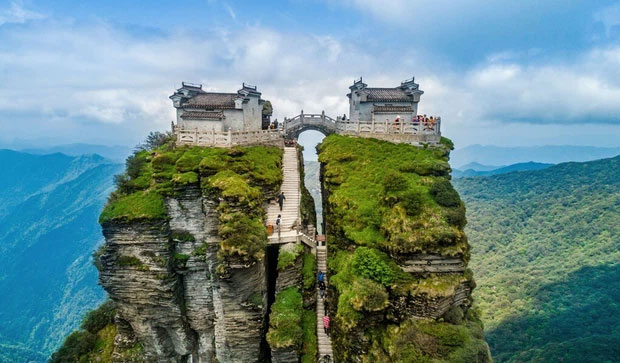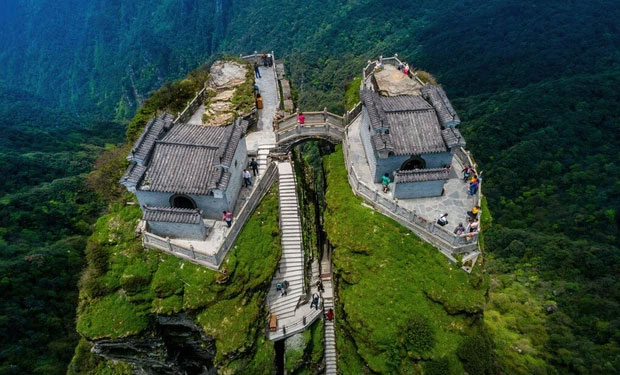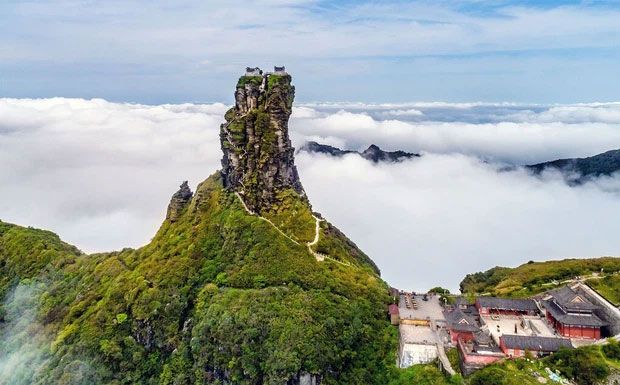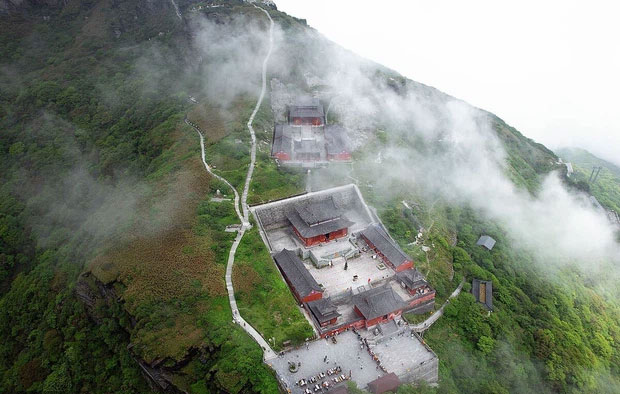Most of the famous temples in China are built in conjunction with high mountains. Climbing a high mountain seems to create a truly sacred atmosphere, especially when shrouded in mist and clouds.
Temples situated close to mountains or on flat hilly terrain are not particularly noteworthy. China has a unique temple complex considered the “most dangerous,” as it is perched atop a steep rocky peak over 2,500 meters high. This is Mount Fanjing – one of the most mysterious mountains in China.

Mount Fanjing is a very famous Buddhist mountain in Guizhou Province, known to the Chinese people as the Bodhi of Maitreya Buddha.
Mount Fanjing stands approximately 2,500 meters above sea level, a towering mountain enveloped in clouds and mist year-round, celebrated as a celestial paradise on earth.
Due to its unique terrain, many people wish to visit this sacred site to pay homage to Buddha. However, without stable physical health, it is impossible to reach the summit. Two temples are located on the two rocky peaks of Mount Fanjing, connected by a precarious stone bridge.

Two temples worship different Buddhist beliefs.
The two temples honor different Buddhist beliefs. One side worships Siddhartha Gautama, referred to as the Hall of Siddhartha, symbolizing the present. The other side venerates Maitreya Buddha, known as the Hall of Maitreya, symbolizing the future.
Remarkably, these two temples are surrounded by red clouds every morning, leading people to call the split peak of Fanjing “Hong Yun Jin Ding”. The path to the mountain is extremely difficult and treacherous. Visitors can only ascend via artificial stone steps, totaling over 8,000 steps.
The ascent requires utmost caution, with visitors needing to grip the steel cables on either side to prevent slipping and falling. Some sections are incredibly rugged, requiring a combination of hands and feet to climb slowly.
Due to the high-risk nature of the ascent, Mount Fanjing limits the number of visitors each day, and the elderly and young children are advised against climbing to the summit.

The ascent must be done with great caution.
Upon reaching the summit, you will find the two temples are not very large, occupying the entirety of the two peaks of Mount Fanjing. The stone bridge connecting the two temples appears to float in mid-air, creating an incredibly dramatic effect.
Standing atop the mountain, gazing at the ancient temple architecture surrounded by thousands of clouds, one feels transported to a celestial realm. Visitors come to pay respects to Buddha, instinctively quieting their steps, sincerely lining up to enter the temple to worship.

The temple on Mount Fanjing has existed for over 500 years since the Ming Dynasty.
Building the temple requires block stone, and repairing the stone bridge also necessitates various materials. In ancient China, without modern machinery, how could the ancients transport such heavy materials to the lofty summit?
To this day, there is no reasonable explanation for this mystery, and no documentation exists to record how construction materials were transported up the mountain. Additionally, researchers have discovered that the temple on Mount Fanjing has stood for over 500 years since the Ming Dynasty.

Building the temple requires block stone, and repairing the stone bridge also necessitates various materials.
Over time, the two temples on the twin peaks have been renovated and reinforced with more durable materials to withstand the harsh winds and environment at high altitudes. However, the structure has retained its original architectural integrity.
The Mount Fanjing area has been designated by the government as a nature reserve in Guizhou Province. The natural environment of Mount Fanjing is home to over 2,000 plant species and hundreds of rare animal species.

The Mount Fanjing area.
Hundreds of millions of years ago, Mount Fanjing gradually emerged from the ocean floor. Stunning landscapes such as steep cliffs, deep valleys, and waterfalls formed between 1 to 1.4 billion years ago still exist today.



















































